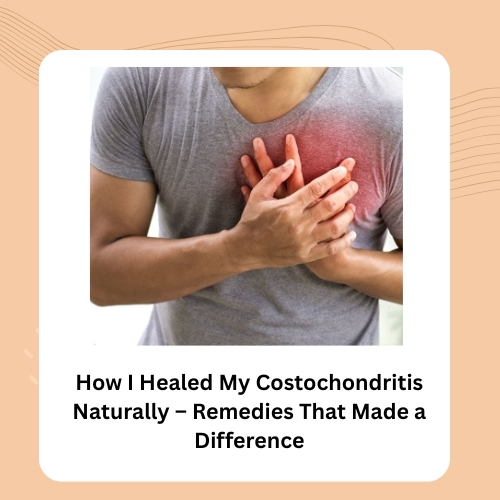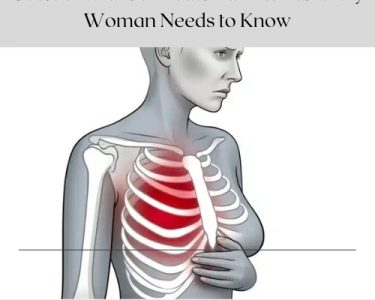Costochondritis, an inflammation of the cartilage where the ribs meet the sternum, is a painful condition that can severely impact your daily life. It can cause sharp chest pain that often mimics a heart attack, which can be frightening. While the causes of costochondritis are still not entirely understood, there are various natural remedies that can help alleviate the pain and inflammation.
What is Costochondritis?
Costochondritis is a condition that causes inflammation of the cartilage that connects your ribs to your breastbone (sternum). This area is called the costosternal junction, and when it becomes irritated or inflamed, it can lead to chest pain that may feel sharp, aching, or pressure-like.
Common Symptoms of Costochondritis:
- sharp or aching pain in the chest
- pain that worsens with deep breaths, coughing, or physical activity
- tenderness when pressing on the ribs near the breastbone
- discomfort that may come and go or persist for days or weeks
What Causes Costochondritis?
The exact cause isn’t always known, but possible triggers include:
- physical strain (like heavy lifting or intense exercise)
- injury or trauma to the chest
- repetitive movement
- respiratory infections
- poor posture
- certain types of arthritis
Naturally – Remedies That Made a Difference
When I was diagnosed with costochondritis, I quickly learned how frustrating it could be. The chest pain was real, constant, and disruptive—but most importantly, it wasn’t my heart. That was a relief. Still, the lingering soreness and flare-ups made everyday tasks uncomfortable. Instead of relying solely on medications, I explored a more natural path. And to my surprise, it worked.
Here are the natural remedies that truly made a difference in managing my costochondritis and bringing me lasting relief.
1. Herbal Supplements for Costochondritis
One of the first natural remedies I turned to was herbal supplements, specifically designed to reduce inflammation and promote healing. I found that some herbs are powerful anti-inflammatories that helped soothe the discomfort associated with costochondritis.
- Turmeric: This golden spice is well-known for its anti-inflammatory properties, thanks to curcumin, its active compound. I started taking turmeric supplements daily, and within a couple of weeks, I noticed a reduction in my chest pain.
- Ginger: Similar to turmeric, ginger has been used for centuries to reduce inflammation. I incorporated ginger tea into my daily routine, and I found it to be both soothing and effective in alleviating pain.
- Boswellia: Also known as frankincense, boswellia is a herb that has been studied for its ability to reduce inflammation. I added a boswellia supplement to my regimen, and it significantly helped with pain management.
- Devil’s Claw: Another potent herbal remedy, Devil’s Claw, is used to reduce pain and inflammation. I took it in the form of a capsule and felt a noticeable decrease in inflammation around my rib cage.
While Herbal Supplement for Costochondritis can be incredibly effective, it’s important to consult with a healthcare provider to ensure they are safe and suitable for your specific situation.
2. Dietary Changes
I also made significant dietary changes that helped reduce the inflammation associated with costochondritis. A diet high in processed foods and sugars can contribute to systemic inflammation, so I focused on eating a more anti-inflammatory diet. Some of the key dietary changes I made included:
- Omega-3 Fatty Acids: Foods like salmon, chia seeds, and flaxseeds are rich in omega-3 fatty acids, which are known for their anti-inflammatory effects. By including these in my meals, I noticed less swelling and pain.
- Leafy Greens: Vegetables like spinach, kale, and broccoli are packed with antioxidants and vitamins that can help fight inflammation. I made sure to include more leafy greens in my diet every day.
- Fruits: Berries, cherries, and oranges contain compounds that can help reduce inflammation. These became staples in my daily fruit intake.
Adopting a diet rich in these anti-inflammatory foods helped my body naturally combat the swelling associated with costochondritis.
3. Heat and Cold Therapy
Another remedy that made a significant difference was the use of heat and cold therapy. For immediate relief, applying a cold compress to the affected area helped reduce swelling. I would do this for 15 to 20 minutes, a few times a day, particularly after physical activity.
For ongoing pain relief, I incorporated heat therapy into my routine. A warm compress or heating pad applied to my chest area helped relax the muscles around my ribs and eased the discomfort.
4. Gentle Exercise and Stretching
Although it was difficult at first, gentle exercise and stretching played a key role in my healing process. Rest is important when you have costochondritis, but too much rest can lead to muscle stiffness and further discomfort. I started with light stretching exercises to improve flexibility and relieve pressure in my chest area. Yoga, especially poses that promote rib expansion and upper body flexibility, proved to be especially beneficial.
As my pain began to subside, I slowly introduced walking and other low-impact activities to increase my mobility and strengthen my muscles without exacerbating the condition.
5. Mind-Body Practices: Stress Management
Stress can often worsen inflammation in the body, so I also focused on stress reduction techniques such as mindfulness meditation, deep breathing exercises, and journaling. These practices helped calm my mind and reduce the physical tension I was holding in my body.
I found that practicing deep breathing every day made a noticeable difference in my overall well-being and contributed to the reduction in pain and inflammation.
6. Quality Sleep
Getting adequate sleep is essential for healing. When I didn’t get enough rest, my body’s ability to repair itself slowed down, and my costochondritis symptoms would worsen. I focused on creating a sleep-friendly environment by eliminating distractions, reducing screen time before bed, and sticking to a consistent sleep schedule.
Conclusion
Healing costochondritis naturally takes time and patience, but with the right approach, it is possible to significantly reduce pain and inflammation. Through a combination of Herbal Treatment For Costochondritis dietary changes, heat and cold therapy, gentle exercise, stress management, and quality sleep, I was able to overcome the discomfort associated with this condition and regain my quality of life.
If you’re dealing with costochondritis, I encourage you to try these natural remedies. However, always consult a healthcare provider before starting any new treatment to ensure it’s right for you. Healing may take time, but with consistent effort, relief is possible.




